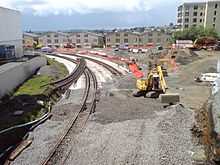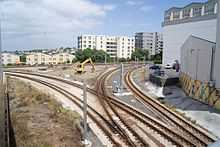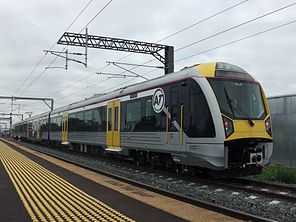Auckland railway electrification


Auckland railway electrification is occurring in phases, as part of investment in a new infrastructure for Auckland's urban railway network. Electrification had been proposed for several decades and work began in the late 2000s after funds were approved from a combination of regional (Auckland Regional Council, later Auckland Council) and central government (New Zealand Transport Agency) budgets.
The contract for the electrification infrastructure was awarded on 14 January 2010 to an Australian and New Zealand consortium,[1] while the contract for 57 trains was awarded on 6 October 2011 to Spanish manufacturer CAF.[2] The first public electric service was on 28 April 2014, on the Onehunga Branch.[3]
Specifications
Power supply
KiwiRail is electrifying all lines between Swanson in the west and Papakura in the south at 25 kV AC,[4] the same voltage as the North Island Main Trunk between Te Rapa and Palmerston North (the Wellington suburban network uses 1500 V DC).
About 3,500 masts will be installed.[5] The Onehunga Branch is the first line to be commissioned.[6]
The system is supplied by two connections to Transpower's 220 kV national grid, one at Mighty River Power's Southdown Power Station and the other at Transpower's Penrose substation. Both connections are duplicated (Penrose has limited duplication due to having only one 220/25 kV transformer), and one connection can supply the entire network if the other one fails, creating a high level of redundancy. KiwiRail says it will use less than 1% of Auckland's electricity capacity.[1] KiwiRail has also approached local lines company Vector about a possible third connection in the central city.[7]
Rolling stock

The decision to electrify was partly prompted by the ageing diesel train fleet becoming unreliable.[8] The fleet comprises diesel multiple units (DMUs) bought second-hand from Perth, Australia, and rebuilt British Rail Mark II carriages in push/pull configuration with DC and DFT locomotives; the Auckland Regional Transport Authority subsequently established that electric trains will be cheaper to run long term. Around the world, cities with high-frequency metropolitan passenger rail services use electric trains, partly because their quieter operation, faster travel between stations and greater environmental benefits.[4]
After electrification a small number of diesel trains will be retained to provide services to Pukekohe.[9] In May 2012, the possibility of extending electrification to Pukekohe was to be investigated by Auckland Transport.[10]
The EMUs are being delivered from 2013, with the last units in 2016.[6] In June 2013, it was confirmed they would be classified AM class (Auckland Metro), with the motor car classified AMA, trailer car AMT, and motor/pantograph car AMP.[11]
Other infrastructure
Crossings, bridges and tunnels
There are 31 public level crossings between Swanson and Pukekohe and eight on the Onehunga branch. With electrification there is a need to safeguard crossings, since electric trains are quieter and more frequent. This includes bridges or tunnels in some cases, and the closure of small suburban street crossings in others.[12] Height restrictions of 4.25 metres or 5.0 metres will be imposed to keep vehicles clear of overhead wires.[13]
The Broadway overbridge in Newmarket and Parnell Tunnel were amongst the first of about 40 structures that needed modification before electric trains can run.[14][15] Tracks are being lowered in Purewa Tunnel on the Eastern Line.[16]
Signalling upgrades
The programme goes hand in hand with a $90 million upgrade to the signalling system.[5]
Station upgrades
Electrification works will go in tandem with construction of a new Parnell Railway Station,[17] and follow upgrades to stations, including Ellerslie (in combination with motorway works), Onehunga (lengthening for 3-car units) and Mount Albert (amenity upgrades).[6]
Maintenance depot
Funding arrangements for the rolling stock purchase included the construction of a maintenance depot and stabling facilities.[18] After looking at potential sites, 4.4 hectares of the old Winstone Quarry in Wiri (next to the South-Western Expressway and bordered by Roscommon and Wiri Station Roads) was selected, being large enough to house all the facilities required and adjacent to the NIMT railway line.[19]
Significant earthworks to prepare the site commenced in January 2011 and in May 2012 a NZ$40 million contract to construct the facility was awarded to Downer New Zealand Limited.[20] The facility was officially opened on 5 July 2013[21] and joint operational control was handed over to the train operator Transdev Auckland Limited and train supplier & maintenance operator CAF on 28 August 2013. The cost of the depot including land, construction and facility equipment was approximately NZ$100 million.
The facility includes six kilometres of sidings and a 7650 square metre depot building consisting of office facilities and the main workshop where servicing of the 57 electric trains takes place. The workshop has seven maintenance berths and has overhead gantry cranes & jacking systems for lifting the trains, high-level platforms to access train roofs, under-floor pits and a wheel lathe. There are an automatic train wash and covered platforms to facilitate cleaning of the inside of the trains.[19] The facility has been future proofed to maintain a fleet of up to 109 electric trains.[22]
The ground floor offices house CAF and the first floor Transdev and staff amenities. The Transdev offices include the depot control office and driver training facilities, which include two train simulators. Each simulator is laid out exactly like the driver’s cab with a large flat screen display in place of the windscreen that displays the view that the driver would see from the cab. The display is programmed with the Auckland railway network, filmed in 2012 and converted into video graphics. The simulator can be set to simulate daytime or night-time and includes a range of weather conditions, and it can simulate faults in the train and emergency situations.[23]
Train movements within the facility are controlled by Transdev staff from the depot control office.
The stabling capacity is 28 electric trains. There are other facilities for stabling at Henderson, Parnell and Papakura.
Funding
The Auckland Regional Council envisaged that a regional fuel tax of five cents per litre would be required to pay for the trains, the upgrade of other rolling stock, above-track infrastructure development including stations and maintenance facilities, ferry terminal upgrades and other transport infrastructure including integrated smartcard ticketing, and the council was to fund the Auckland Regional Transport Authority to buy electric trains and to operate services, and to provide stabling and maintenance facilities.[4] The infrastructure was to be paid from national funds.
However, the Fifth National Government cancelled the proposed tax, with the electrification to be paid for by central government. This move has been heavily criticised for leaving the electrification in doubt for a time, for delaying parts of the project, such as train tendering,[24] and for putting control of Auckland public transport into Wellington's hands.
In late 2009, the government confirmed that $500 million in loans would be extended to KiwiRail to enable it to proceed with tendering for the rolling stock, a process that the cancellation of the fuel tax had interrupted by at least half a year.[25] The fact that the money was only a loan, with no means provided for Auckland or KiwiRail to raise extra funds to repay it (as was intended to be done with the regional fuel tax), was criticised strongly in Auckland, as it would mean that Auckland would pay for the trains yet not own them.[26]
In mid-2011, after long negotiations between Auckland Council/Auckland Transport and the government, it was announced that the trains would be owned by Auckland, with Auckland paying approximately half of the cost from rates, and paying annual track access charges to KiwiRail and any potential purchase price increases as the winning tenderer is finalised.[18]
Timeline
- 2007, Electrification announced
It was announced on 17 May 2007 (as part of the 2007 New Zealand budget) that electrification would proceed, to be complete in 2013.[9]
- 2008, Regional fuel tax law passed
On 3 July 2008 a law was passed allowing regional fuel taxes to fund large capital projects, of up to 10c a litre but limited to 2c in 2009 and 5c in 2010. The National Party criticised the funding mechanism. [27]
- 2009, Regional fuel tax cancelled
Before the regional fuel tax could be implemented a change in government occurred, and the incoming National government cancelled the fuel tax in early 2009, though electrification was still to be funded.
- 2009, Government funding confirmed
In November 2009, government confirmed $500 million in loans to KiwiRail to allow the interrupted purchasing process for the electric trains to continue.[25] [This was later clarified as a loan that Auckland would have to repay, without a mechanism to fund the extra cost. After negotiations between central and local government, this was reduced in severity by government providing over half of the purchase cost as a subsidy, with the rest still to be paid from rates.]
- 2010, Electrification contract awarded
On 14 January 2010 KiwiRail announced that it has awarded the contract for electrification to a consortium of Hawkins Infrastructure, a division of New Zealand company Hawkins Construction, and Laing O'Rourke Australia, for NZ$80 million.[5]
- 2011, Construction of EMU maintenance and stabling depot begins
4.4 hectares of the old Winstone Quarry in Wiri was selected as the site of a maintenance and stabling facility for the new trains. Earthworks preparing the site started in January 2011 and construction of the 7650 sq m building and the six kilometres of sidings in the stabling area commenced in May 2012.[19]
- 2011, Train manufacture contract awarded
On 6 October 2011, CAF was confirmed as the successful tenderer, for approximately $400 million.[2]
- 2013, Wiri EMU maintenance and stabling depot opened
On 5 July 2013 Auckland Mayor Len Brown officially opened the facility.[21]
- 2013, The first electric train is delivered to the depot
On 26 August 2013 the first train (unit number AM 103) was delivered by truck to the depot for certification.[28] The train was officially unveiled during a ceremony at the depot on 12 September 2013.[29]
- 2014 Scheduled EMU passenger services begin
On 28 April 2014 the first EMU passenger trains entered regular service between Britomart and the Onehunga Branch line. Three EMU's were used that day with unit AM 129 being the first in service, departing Onehunga at 05:46 followed by AM 116 at 06:10 and AM 103 used as a standby spare.
Stages of completion
KiwiRail announced the works would be implemented in five phases:[5]
Stage 1
- Southern line, Otahuhu-Britomart
- Western line, Newmarket-Morningside
- Onehunga Branch.
Stage 2
- Western Line, Morningside-Swanson
Stage 3
- Southern Line, Otahuhu-Puhinui
- Manukau Branch.
Stage 4
- Southern Line, Puhinui-Papakura.
Stage 5
- Eastern line, Westfield-Quay Park Junction (near Britomart)
Progress
During the summer 2011-2012 shutdown, the approaches to Britomart were rebuilt to allow for electrification, masts installed and holes bored, and wiring completed in some areas.[30] During the 2013-2014 shut-down, the complex job of wiring Quay Park Junction, The Strand stabling facility and Britomart was completed. By January 2014 wires had been installed:
- Western Line: Swanson-Mount Albert, Newmarket-Britomart;
- Southern Line: Britomart-Papakura;
- Eastern Line: Britomart-Purewa Tunnel south end;
- Manukau Branch (near complete);
- Onehunga Branch.[31]
Services were planned to start during April 2014[32] and the first scheduled electric train service (from Britomart to Onehunga) took place on 28 April 2014.
See also
References
- ↑ 1.0 1.1 "KiwiRail awards Auckland rail electrification contract". Radio New Zealand. 14 January 2010. Retrieved 14 January 2010.
- ↑ 2.0 2.1 "Train contract heralds new era in public transport". Auckland Transport Press Release. 6 October 2011. Retrieved 6 October 2011.
- ↑ "'Stunning' electric trains launched - but soon face delays". New Zealand Herald. 28 April 2014.
- ↑ 4.0 4.1 4.2 ARC, Rail Electrification
- ↑ 5.0 5.1 5.2 5.3 "An electrifying start". Manukau Courier. 25 February 2010. Retrieved 14 January 2011.
- ↑ 6.0 6.1 6.2 "EMU, Depot and Electrification Infrastructure". Report to the Auckland Council Transport Committee. 7 December 2011. Retrieved 22 December 2011.
- ↑ "Electricity Asset Management Plan 2012 – 2022". Vector Limited. April 2012. p. 5.75. Retrieved 21 April 2012.
- ↑ "City rail commuters in for rough ride". The New Zealand Herald. 22 May 2011. Retrieved 15 August 2012.
- ↑ 9.0 9.1 21st century public transport for Auckland - Auckland Regional Transport Authority, Thursday 17 May 2007
- ↑ Mathew Dearnaley (22 May 2012). "Push for electric to Pukekohe". The New Zealand Herald.
- ↑ "Progress on new EMU cars for Auckland". New Zealand Railfan 19 (3): 14–15. June 2013. ISSN 1173-2229.
- ↑ Dearnaley, Mathew (15 March 2008). "$21m 'wonderful' news for rail safety". The New Zealand Herald. Retrieved 17 September 2011.
- ↑ "Height Restrictions at level crossings in Auckland". KiwiRail. Retrieved 22 September 2012.
- ↑ Dearnaley, Mathew (8 January 2010). "Struggle to get tracks ready for Big Day Out". The New Zealand Herald. Retrieved 12 January 2011.
- ↑ Dearnaley, Mathew (5 October 2007). "First steps towards electric rail". The New Zealand Herald. Retrieved 14 January 2011.
- ↑ Dearnaley, Mathew (10 January 2011). "Trains back on track after two week shutdown". The New Zealand Herald. Retrieved 10 January 2011.
- ↑ "ARC presses for Parnell train station". The New Zealand Herald. 30 September 2010. Retrieved 12 January 2011.
- ↑ 18.0 18.1 Dearnaley, Mathew (2 September 2011). "City gets 50pc more electric trains". The New Zealand Herald. Retrieved 2 September 2011.
- ↑ 19.0 19.1 19.2 "The Wiri Maintenance and Stabling Facility". Auckland Transport Press Release. 5 July 2013. Retrieved 31 August 2013.
- ↑ "Downer to build train depot for Auckland Transport in New Zealand". Railway Technology. 16 May 2012. Retrieved 2 September 2013.
- ↑ 21.0 21.1 "Maintenance and stabling facility opens for Auckland's new trains". Auckland Transport Press Release. 5 July 2013. Retrieved 31 August 2013.
- ↑ "Auckland Transport Awards Trains Depot Construction Contract". Scoop. 14 May 2012. Retrieved 2 September 2013.
- ↑ "Learning to drive Auckland's new trains". Auckland Transport. 12 August 2013. Retrieved 2 September 2013.
- ↑ "Brian Rudman: Promised electric trains derailed by misguided enthusiasm". The New Zealand Herald. 1 June 2009. Retrieved 21 February 2010.
- ↑ 25.0 25.1 $500m electric train boost 'historical' for Auckland - ARC - The New Zealand Herald, Tuesday 24 November 2009
- ↑ Dearnaley, Mathew (26 May 2011). "Auckland wants to own trains, not lease them". The New Zealand Herald. Retrieved 17 June 2011.
- ↑ Nats attack new fuel tax law - The New Zealand Herald, 4 July 2008
- ↑ "Auckland’s first new train has arrived". Auckland Transport Press Release. 26 August 2013. Retrieved 31 August 2013.
- ↑ "Electric trains unveiled". Retrieved 12 September 2013.
- ↑ "Auckland rail electrification: current activities". KiwiRail. Retrieved 17 January 2012.
- ↑ "Auckland's rail network – electrification map". KiwiRail. 3 October 2012. Retrieved 22 May 2013.
- ↑ "Auckland's first electric trains on track in April despite setbacks". New Zealand Herald. 18 May 2013.
External links
- Campaign for Better Transport (campaign for improvements to (mainly public) transport in Auckland)
- "Auckland railway electrification (download maps etc)". KiwiRail. Retrieved 20 February 2012.
- "Auckland railway electrification (Current activities, 2012)". KiwiRail. Retrieved 20 February 2012.
- "Auckland railway electrification (Clearances, download maps etc)". KiwiRail. Retrieved 20 February 2012.
- "Auckland railway electrification (FAQs about level crossing clearances)". KiwiRail. Retrieved 20 February 2012.
- "Auckland railway electrification (Signalling & Traction)". KiwiRail. Retrieved 20 February 2012.